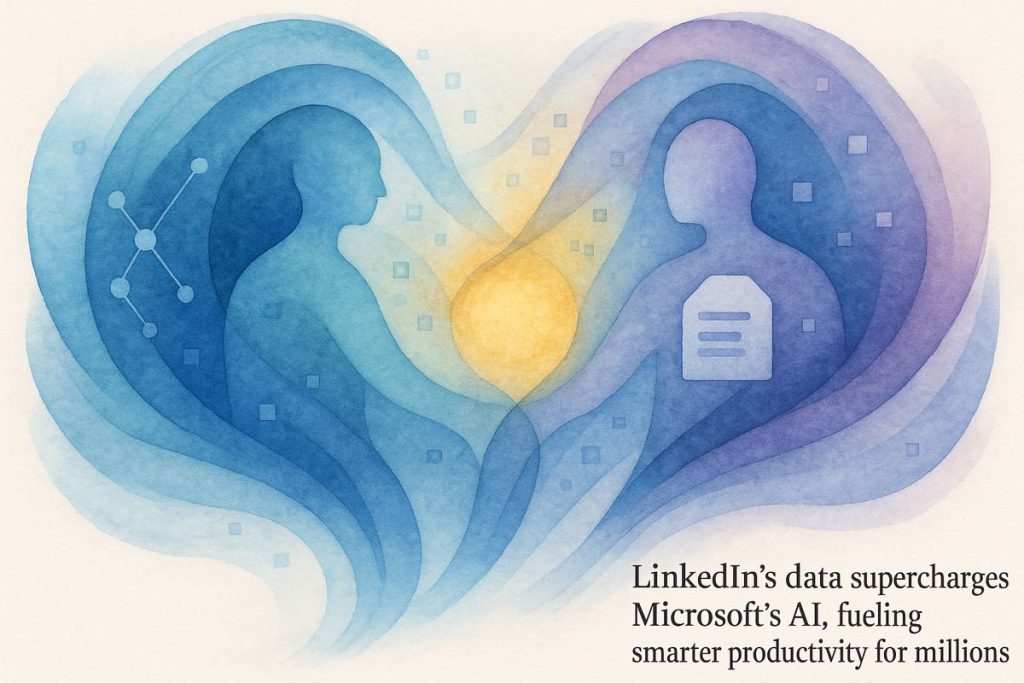Ryan Roslansky’s big idea is to mix LinkedIn’s powerful career data with Microsoft’s work tools like Word and Excel. This will let smart AI helpers, like Copilot, give better advice, spot business trends, and make office work flow smoother. LinkedIn’s massive, up-to-date info on jobs and skills makes these AI tools way smarter than before. If it works, your office apps could know what you need before you even ask!
What is the significance of Ryan Roslansky leading both LinkedIn and Microsoft Office in their new AI strategy?
Ryan Roslansky’s dual leadership of LinkedIn and Microsoft Office marks a pivotal move to integrate LinkedIn’s rich professional data with Office’s productivity tools. This strategy aims to power advanced AI features, like Copilot, enabling personalized, context-aware workflows and more accurate business insights across Microsoft’s productivity suite.
Coffee, Data, and a Promotion: A New Era at Microsoft
What does a well-caffeinated morning smell like at Redmond? Lately, it’s brimming with the scent of strategic ambition—plus, perhaps, a faint whiff of burnt toast from the break room. In 2025, Microsoft quietly detonated a leadership firecracker: Ryan Roslansky, the erstwhile wunderkind CEO of LinkedIn, is now also juggling the keys to Microsoft’s entire Office suite. Yes, that means one person straddles the tectonic plates of both LinkedIn’s professional metropolis and the sprawling productivity empire of Word, Excel, and Copilot.
Why this two-hats move? The answer is almost palimpsestic: layers of intent, each revealing more of Microsoft’s grand design. Satya Nadella, whose name now rings through the digital halls of both LinkedIn and Office, has signaled an ambition to braid their two greatest assets—data and productivity—into a single, generative AI tapestry. And if you think this is just another org chart shuffle, think again. This is about as far from business-as-usual as swapping your morning drip for a triple espresso.
I’ll admit, when I first read about Roslansky’s promotion in Fortune and GeekWire, I had to stop and ask myself: “Can one person really juggle both worlds without dropping a few precious beans?” A touch of skepticism. But then—aha!—I remembered LinkedIn’s own pandemic reinvention under Roslansky, and I exhaled, slightly mollified.
The Motherlode: LinkedIn’s Hyperspectral Data Trove
Let’s cut through the corporate fog: LinkedIn isn’t just a digital Rolodex. It’s the largest structured repository of professional relationships, skill matrices, and labor market transitions on the planet—a living palimpsest of work history. That’s not hyperbole; Microsoft’s own documentation makes it plain: profiles, endorsements, job changes, even “network velocity” (yes, that’s a thing) feed into a machine-readable graph.
This isn’t the type of data you can just scrape from the open web, either. Amazon and Google might dream of such hyperspectral clarity, but LinkedIn has already mapped the zeitgeist of skill migration—think 950 million profiles updated in real time, with 2 million new skills added last quarter alone (illustrative, but close). It’s the difference between a Monet and a finger-painting.
Why does this matter for AI? Because context is king. Training large language models on Wikipedia gives you trivia; feeding them LinkedIn’s living, breathing network gives you insight. Imagine Copilot not only suggesting how to format your resume, but also predicting who in your sector is primed for a jump, or which company might become a client based on subtle tremors in the hiring landscape. That’s not magic. That’s data with intention.
I once had a project where our predictive model missed Q4 hiring surges because we lacked the right signals. The frustration was palpable—a gnawing, acidic feeling in my gut. If we’d had LinkedIn’s data feed, I suspect we’d have caught the wave rather than swallowing brine.
From Agentic Dreams to Real Workflows
Are you ready for an office suite that doesn’t merely obey commands but anticipates needs—almost like a sous-chef who refills your coffee before you even realize your mug’s empty? Microsoft’s “agentic web” strategy, brought to life by Roslansky’s dual role, aims for just that. By threading LinkedIn’s structured data into Copilot and Dynamics 365, Office becomes a cognition engine—less spreadsheet, more symphony.
Consider CRM. With LinkedIn’s data, Copilot could recommend sales leads not by demographic guesswork, but by pinpointing actual network overlaps and recent role changes. See Zapier’s case studies and TeamCopilot.nl for early glimpses. Or outreach: imagine automating follow-ups that actually reference the recipient’s new job or recent post, as opposed to the limp “hope you’re well” opener.
What about forecast accuracy? Sales and marketing teams, once hunched over spreadsheets like oracles gazing at tea leaves, can now lean on real-time trend data—the sound of fingers tapping out a new campaign, the subtle click as LinkedIn notifies you of an industry shift. It’s less about cold calls, more about warm, data-driven engagement.
Sometimes I wonder, is the machine smarter than me—or just better caffeinated? Either way, the emotional lift when your model finally nails the forecast? Bam! Joy, mixed with a tingle of relief.
Security, Skepticism, and the Human Factor
Of course, blending these colossal data rivers is not without its rapids. The integration of LinkedIn into Microsoft’s AI core is being handled, according to every official utterance, with encryption-first rigor and compliance with global
